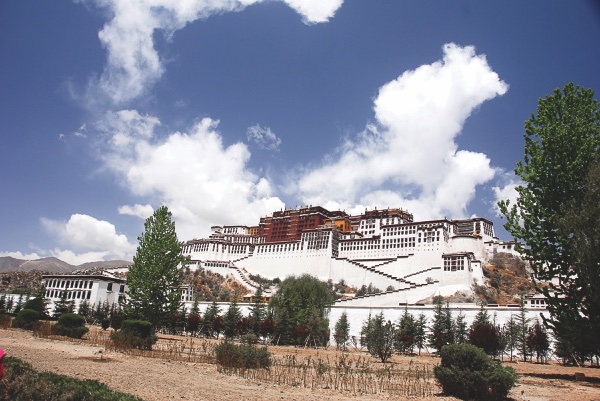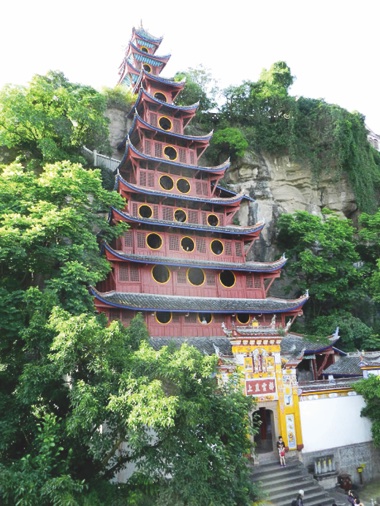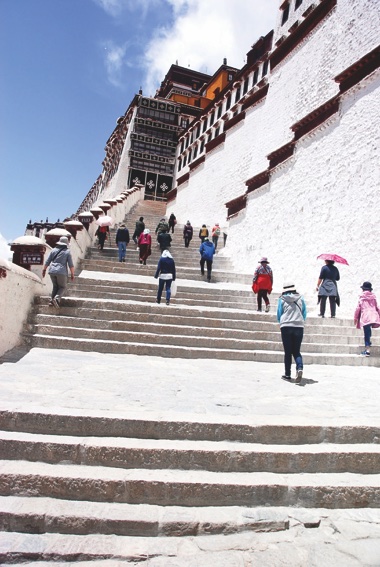As we all know, Tibet has mountains and most of the country is at a much, much higher altitude than Chicago. Where smog might have been an issue in China, just getting oxygen may be an issue in Tibet. While it won’t be on your schedule, you may feel like you are climbing Everest itself.
Lhasa sits at 12,000+ feet, so beware that the altitude might just be a problem. My friends had been to Machu Pichu before but this is much higher. Climbing stairs or walking fast set their lungs burning. Others on the tour couldn’t sleep, had vicious headaches or stomach problems, and unfortunately some had all three. If you think you might suffer from any of these symptoms, check with your doctor if you plan on making the trip.
One major fact, or animal, you need to be familiar with if you travel to Tibet, is the Yak. Basically, it’s a shaggy-haired wild ox that is used for multiple purposes in Tibet: pack animal, dairy, meat source and its hide for everything else. Why you ask? Well, your first meal in a Tibetan restaurant will most likely include yak meat. Since it is in the cattle family, most people find it tasty. While most of the dishes were great, my friends did pass on the stuffed yak lung.

Potala Palace was once home to the Dali Lama. (Photos provided)
The highpoint of any visit to Tibet and Lhasa is the Potala Palace. It was built in the 17th Century on top of the original 7th century site and has more than 1,000 rooms. The visit includes the Red Palace where the Dali Lama used to live. There are over 10,000 chapels and a labyrinth of “mysterious dungeons” where you could get lost forever. It took 7,000 workers and 1,500 artists and craftsmen more than 50 years to build. It also has more than 345 steps and many steeply inclined ramps. Being built before electrified lighting, it is dark and lit only by, yes; you guessed it, yak butter candles. You will soon recognize the aroma from the candles so prepare yourself because they are the primary source of light and drip onto the floor. As such, the floors become very slippery so move with caution.
Make sure your tour includes the magnificent stupas, the burial tombs of most of Tibet’s Dalai Lamas. Our friends didn’t and were upset that they missed it. The largest was 49 feet tall and was covered with 3,721 kilograms of gold adorned with 20,000 jewels and diamonds. This particular Dalai Lama (the fifth) lived a long time and accumulated many good deeds during his term. One of the other stupas only had 325 kilograms of gold, and yet another only had 175 kilograms of gold. The size of the stupa and amount of gold and jewels was based on the length of their life and therefor the accumulation of good deeds by that Dalai Lama. An exception to this basic rule was the thirteenth Dalai Lama’s stupa. It was 46 feet tall, made of silver and covered with 600 kilograms of gold and studded with coral, amber, agate, diamonds and other precious jewels. This stupa is reputed to be ten times more valuable than the fifth Dalai Lama’s stupa. Not sure what he did, but must have been very positive.

One of the other obvious things you will notice in Tibet is the Chinese Police State. Sometimes they are in the background, other times very conspicuous, but in either case, always around. There are also many “photo restricted” areas so be cognizant of the signs or instructions from your tour guide. No one wants to spend any time in a Chinese prison!
Another major attraction is Barkhor Square with the Jokhang Temple at its center. The temple is accompanied by the Bazaar, which has concentric circles of vendors surrounding it. The temple is revered and with Buddhism the core of these people’s lives, many will traverse the circular area daily. Some are circling with their prayer wheels while others walk a number of steps and then prostrating themselves. Most are chanting during the experience. The walk is a sort of pilgrimage, with some walking hundreds of miles to get here while others live across the street. A major goal in one’s life is to have a place close to this temple so they can do the 1K circuit every day.

Remember the Yak butter? People bring pitchers of it to “refresh” the thousands of candles in the temple. Be careful not to jostle a person with a gallon of Yak butter but that shouldn’t be a problem because you will be literally taking baby steps the whole time since you’re hemmed in so tightly. There are ancient people, babies, and hundreds of monks in red robes all chanting sutras and spinning prayer wheels and a zillion Buddha statues. The most famous Buddha is the golden 7th Century one. The crowded conditions may dictate whether you will get to see it or not. My friends were turned away just yards from seeing the Buddha. Also, don’t be surprised to see multiple check-points in the square with a large police presence, some even with SWAT vests in English! The square has been the site of numerous demonstrations with sometimes brutal crackdowns by the police.
Once you get tired of climbing steps, you can switch to ladders. The Sera Monastery is only accessible by climbing up very steep ladders. Fortunately, the Monastery was the last point before moving on to Chongqing and leaving Tibet for the Yangtze River cruise
The tour spent a day in Chongqing before the trip down the Yangtze. First stop via boat is the Three Gorges Dam Museum. It is stressed numerous times how harnessing the Yangtze has saved many lives previously lost to the river’s dangerous storms and flooding. Not mentioned are the countless town flooded or demolished in the construction and subsequent relocation of the populous. The highpoints are greatly presented with negatives lost to the annuals of time.
Last stop – Shanghai. This was the only city where words of caution were uttered by their guide. They were advised to NOT accept invitations by anyone to go into a bar or restaurant for food or drink as you would be significantly overpriced, i.e. $1,200 for a bottle of booze and if you don’t pay, they will beat you up! Enough caution to keep you staying with the group. But, otherwise, Shanghai was rated the top city on the tour, a blend of both the Old and New China. Other rules that may get you arrested: no chewing gum or spitting on the sidewalk. Their tour group was divided up into smaller units and sent off to have lunch with a local family. This was one of, if not the best, meals they had on the entire trip. Then to the airport and back home.
All’s well that ends well, but it helps to be prepared.




